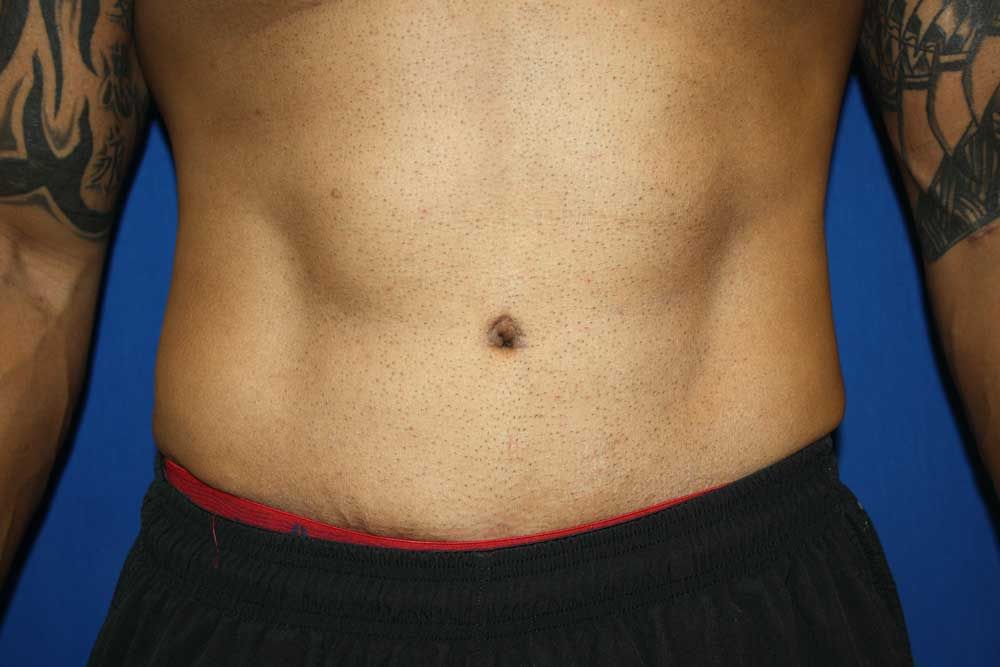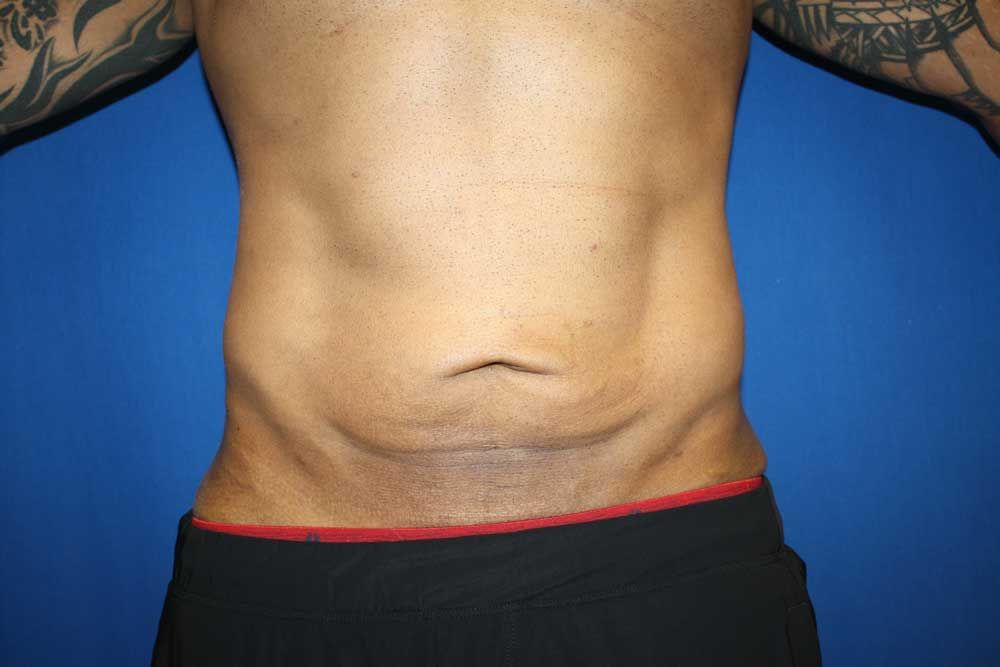Tummy tuck surgery, or abdominoplasty, is among the most popular plastic surgery procedures today. If you live in Fort Lauderdale or Broward County and are unsatisfied with unsightly rolls of fat in your abdomen, consider a tummy tuck performed by the skilled and expert hands of double board-certified plastic surgeon Nathan Eberle, M.D., D.D.S., at the Weston Center for Plastic Surgery.
| Avg. Surgery Time | 2-3.5 hours |
| Anesthesia | General |
| Location | Certified in-office Operating Room, Outpatient Surgery Center or Hospital. Dr. Eberle will discuss which setting is right for you; most patients go home from an ambulatory setting. |
| Recovery | Back to work in 2-3 weeks Back to full exercise in 6 weeks (if undergoing muscle repair/plication) |
| What makes your experience difference with Dr. Eberle? | EXPAREL included in your fee to reduce or eliminate your pain for the first 2-3 days Lower extremity compression devices for home use to help prevent/avoid blood clots Overnight stay in hospital if desired Scar recovery program included in your surgical package |
| Am I a Good Candidate | Healthy Non-smoker? Non-smoker Have excess fat and skin BMI less than 35 Realistic goals and expectations |
WHAT IS A TUMMY TUCK?
Tummy tucks are a popular form of plastic surgery focusing on the abdomen. During this procedure, known medically as abdominoplasty surgery, excess skin is trimmed away, fat is removed, and the natural tissues are lifted to make the stomach region look smoother and more toned.




BENEFITS OF A TUMMY TUCK
In addition to improving your overall appearance by flattening the tummy and restoring a more youthful silhouette, tummy tuck surgery also has other advantages. Following extreme weight loss, pregnancy or some medical conditions, the stomach muscles may become weak and distended, and unresponsive to diet and exercise. Tummy tuck surgery surgically tightens weak muscles and removes excess skin and fat, to flatten, tighten and strengthen the abdomen. Weak abdominal muscles may also cause an inward curvature of your spine or sway back. Following tummy tuck surgery patients often notice that their posture improves significantly because the newly tightened abdominal muscles now support their spine. The improved support and better posture can have the added benefit of relieving certain types of back pain, while also adding to a more trim and youthful appearance.




TUBELESS TUCK
For those who are candidates, Nathan Eberle, M.D., D.D.S., F.A.C.S. is proud to offer the Tubeless Tuck option for abdominoplasty/tummy tuck patients in Fort Lauderdale and Broward County at the Weston Center for Plastic Surgery.
The revolutionary Tubeless Tuck technique completely eliminates the need for messy, painful drains by replacing them with dissolvable sutures that close up the area and prevent the buildup of fluid.
WHY ARE DRAINS USED AT ALL?
Drains are utilized in order to reduce the accumulation of fluid under the skin that sometimes will occur as a side effect of tummy tuck surgery. Serous fluid tends to build up underneath the skin after a tummy tuck, which can lead to a seroma. Seromas often lead to infection which then results in further corrective procedures and needing antibiotics in order to treat the infection. By employing the Tubeless Tuck technique during surgery, Nathan Eberle, M.D., D.D.S., F.A.C.S. is able to significantly reduce the risk of this accumulation of serous fluid without the need for drains.
HOW DO MOST PEOPLE FEEL ABOUT DRAINS?
One of the most difficult parts of undergoing a tummy tuck can be the existence of the closed suction drains that the surgeon attaches to both hips. These remain inside the body for up to two weeks post-surgery. The drains help prevent fluid buildup but are very inconvenient as they require emptying anywhere from two to four times each day.
With a classic tummy tuck, patients are released from the surgical center post-surgery with drains in place. Their level of discomfort is typically much greater overall as the drains are small plastic tubes that actually protrude through their skin. These patients often require painkillers to help with the discomfort experienced as a result of any pulling on the sutures at the drains’ attachment sites. They may also require help in caring for the drains by keeping a record of the volume of liquid being released. The drains may leak blood and other bodily fluids onto surfaces such as furniture and clothing. In addition, further scarring often results as separate incisions/cuts are created for the drains or they are pushed out through openings in the incision site on the abdomen.
Antibiotics are often prescribed as a part of the patient’s aftercare so as to prevent potential infections from developing around the plastic drains. In today’s era of “superbug” infections, preventing infection, and thus reducing the need for additional antibiotics, helps decrease the risk of developing antibiotic-resistant infections in addition to lessening their side effects.




IS A TUMMY TUCK RIGHT FOR ME?
If you don’t like the way your stomach looks, a tummy tuck may be right for you. Most candidates complain that they have hanging skin over their abdomen that makes the area look flabby or out of shape. This surgery is particularly popular among patients who have lost a significant amount of weight or who have been pregnant, as both events can result in excess skin and fat in the abdomen. Ideal candidates are in good general health and are at a stable weight.
HOW INVOLVED IS THE TUMMY TUCK PROCEDURE?
A tummy tuck is major abdominal surgery and is a fairly involved procedure. It requires general anesthesia and can take as long as three to four hours. An incision is made in the lower abdomen, generally low enough that it can be covered with underwear, bathing suit, or pants. This incision allows the surgeon to access all of the underlying tissues of the abdomen. First, excess fat is removed. The abdominal muscles may be tightened, especially if the patient has been pregnant, as pregnancy tends to loosen these muscles. The belly button may be moved back to its normal position on the abdomen. The natural tissues are lifted and sculpted to provide a smooth, toned-looking result, and excess skin is trimmed away. Finally, the incision is closed with sutures. Nathan Eberle, M.D., D.D.S., F.A.C.S. uses EXPAREL®, a non-narcotic local analgesic, to minimize pain before you wake up from surgery, making the days after surgery more comfortable.
HOW LONG IS THE RECOVERY AFTER A TUMMY TUCK?
After the tummy tuck surgery, patients can expect the recovery process to last up to a month. During the first two or three days, bed rest is recommended. Patients can then begin to gradually return to their normal activity levels. During this time, it is common to experience some discomfort, soreness, bruising or swelling. Many patients find that their incision area feels tight or itchy. The surgical site is covered with a compression garment to promote healing. Most patients are back to work within three to four weeks, though it can take up to three months to feel fully healed.
HOW MUCH DOES A TUMMY TUCK COST?
The cost of a tummy tuck varies significantly from patient to patient depending on the amount of surgical work required. Financing is available.
WHAT SHOULD I DO NEXT?
If you live in Fort Lauderdale or Broward County and are looking for a way to dramatically enhance the contours of your stomach area, tummy tuck surgery may be right for you. Contact double board-certified plastic surgeon Nathan Eberle, M.D., D.D.S., at the Weston Center for Plastic Surgery today for your consultation.








